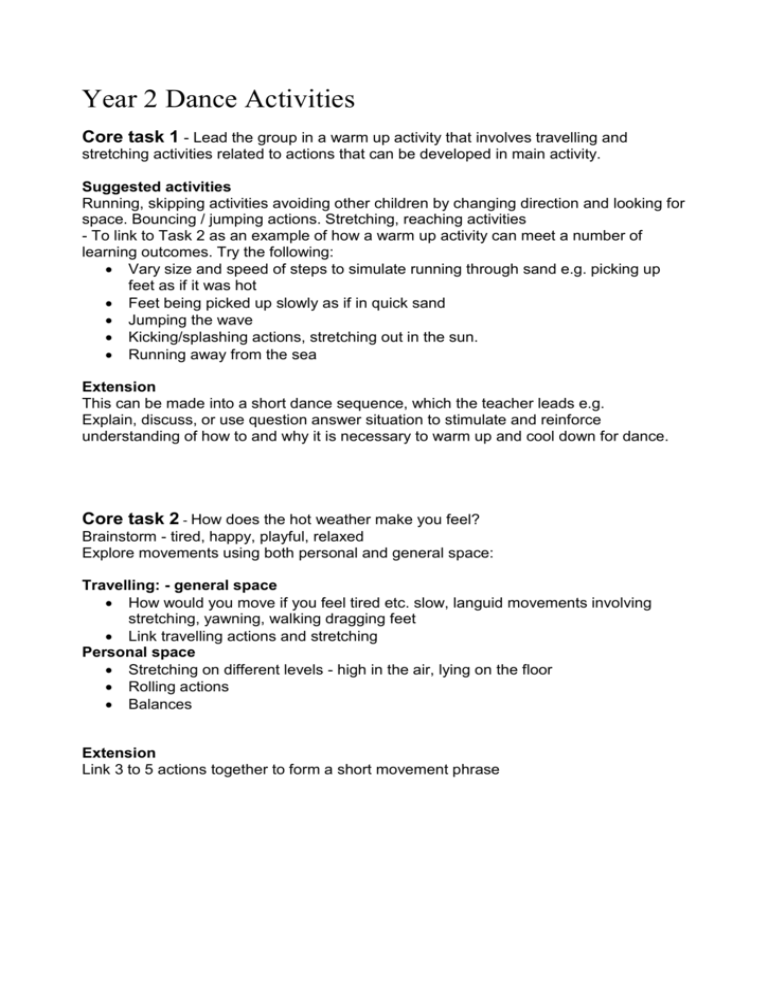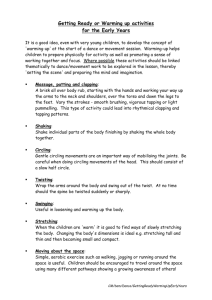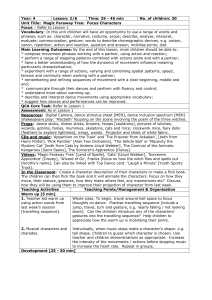Y2DanceActivities - Hertfordshire Grid for Learning
advertisement

Year 2 Dance Activities Core task 1 - Lead the group in a warm up activity that involves travelling and stretching activities related to actions that can be developed in main activity. Suggested activities Running, skipping activities avoiding other children by changing direction and looking for space. Bouncing / jumping actions. Stretching, reaching activities - To link to Task 2 as an example of how a warm up activity can meet a number of learning outcomes. Try the following: Vary size and speed of steps to simulate running through sand e.g. picking up feet as if it was hot Feet being picked up slowly as if in quick sand Jumping the wave Kicking/splashing actions, stretching out in the sun. Running away from the sea Extension This can be made into a short dance sequence, which the teacher leads e.g. Explain, discuss, or use question answer situation to stimulate and reinforce understanding of how to and why it is necessary to warm up and cool down for dance. Core task 2 - How does the hot weather make you feel? Brainstorm - tired, happy, playful, relaxed Explore movements using both personal and general space: Travelling: - general space How would you move if you feel tired etc. slow, languid movements involving stretching, yawning, walking dragging feet Link travelling actions and stretching Personal space Stretching on different levels - high in the air, lying on the floor Rolling actions Balances Extension Link 3 to 5 actions together to form a short movement phrase Core task 3 - Imagine the types of activities that you might get up to on the beach Stretching in the sun Playing in the sea Making sandcastles Shivering, drying yourself in a towel Swimming actions Explore the actions either individually or as a pair, exaggerate them i.e. make them slower and bigger. Compose a class dance by giving each small group or pair a task card with one of the activities on to develop one short sequence consisting of three different movements (either travelling or gestures). Extension They perform either one after the other or two or three groups at a time in an order organised by the teacher. As each group performs the others hold a shape or position (stillness). Finish and start the dance with a running towards and away from the sea. Core task 4 - Slip, slap, slop sequence Using this catch phrase from Australia, which is used to remind adults and children to protect themselves from the sun. Devise a motif/movement phrase using actions to express the following: Slip on a shirt Slop on some sunscreen Slap on a hat Working in pairs or individually children can explore the actions related to these activities. They can examine the words themselves in detail; what does slip or slippery feel and look like e.g. smooth continuous movement Slop - sudden movement into a more continuous motion Slap - sudden, strong movement Devise a motif for each of the phrases and then link them together with some travelling actions to form a short dance. Extension Devise a motif which links all the phrases together and then use work explored in previous tasks to form a dance in which the motif is then repeated as a chorus. Core task 5 - A Foggy Day Warm-up based on running and swirling and twirling actions, swooping down to the ground and lifting up high to the sky, using arms to lead the movement. The warm-up reflects the way in which fog moves. Show photographs of fog or any video clips from films as a stimulus. Question/Answer - how does the fog make you feel? Cold Creepy Frightened Lonely Individually explore actions that make you feel like those words. How would you travel to show that you were? Cold - shivering and shaking, wrapping arms around body, shaking different body parts, blowing on hands, running to keep warm. creepy - think of spiky shapes, stretching high and crawling along the ground, slow strong movements. frightened - shaky, slow movements followed by a quick run, repeat in different directions, sudden jumps. lonely - wandering with no clear direction, dragging feet, looking towards something then looking away. Core task 6 - Children need to close their eyes and imagine a) They are in an enclosed space they cannot see but they are to feel their way around a very small room, exploring the boundaries with their hands - think of using different levels. b) They are exploring a bigger space moving around freely sweeping branches/fog out of their way. c) As they meet each other they touch hands and jump away suddenly moving off in a different direction. Extension Combine all of the above to develop a whole class dance. Use repetition to help formulate composition e.g. aba, or abcabc, or abac Core task 7 - Combine elements from task 5 and 6 to produce a whole class or small group dance. Use a poem about fog as a stimulus for the movement. Core task 8 - Historical Elements Compare the travelling fairs of medieval times to the modern fairgrounds of today. Use video clips and photographs to show the types of acts and activities that were performed e.g. The strong man Juggling The dancing bear Fortune tellers etc Explore the way in which ‘the strong man’ might move and pose - strong, slow movements, chest pushed out, strutting. Demonstrate the different shapes he holds to show off his physique /muscles. Experiment with pushing/pulling/ holding movements in relation to effort Explore holding balances/stillness/shape to make it look like you holding or taking a heavy weight Extension Select four different actions and link them together using a ‘strong man strut’ for eight counts. Core task 9 - Juggling motifs Look at pictures or watch a film clip of juggler to see how they move. Study how they stand and move their feet. Look at how they focus their eyes on the balls Watch the way in which the arms and hands move, the air patterns that they are making. The children can explore the actions one by one initially and then start to combine them until they have composed their own juggling motif. Develop it by adding turns and jumps and changes of level.





